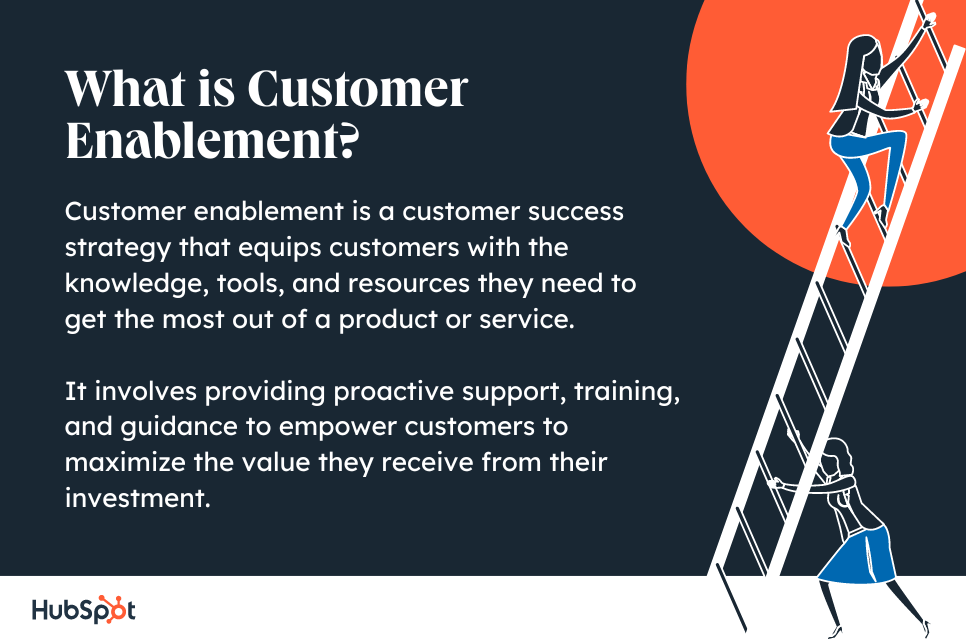This strategy involves providing proactive support, training, and guidance to empower customers to maximize the value they receive from their investments.

Customer enablement takes a team to carry out, and customer enablement managers have a responsibility to lead that strategy successfully.
Customer Enablement Manager
Customer success teams will hire enablement managers to carry out duties such as:
- Develop and execute customer enablement strategies to drive the adoption and usage of products or services.
- Create and deliver customer training programs and materials, including webinars, documentation, and instructional videos.
- Analyze customer usage data to identify trends and opportunities to improve customer enablement initiatives.
- Act as a subject matter expert on the products or services offered, providing guidance and support to customers and internal stakeholders.
- Continuously evaluate and refine customer enablement programs to ensure effectiveness and customer satisfaction.
- Establish relationships with key customers, gathering feedback and insights to inform future enablement efforts.
- Lead a team of customer enablement specialists, providing coaching and mentoring to ensure their success in achieving customer adoption and usage goals.
-
Personalize your customer enablement strategy for each customer.
54% of consumers say they expect all experiences to be personalized. Additionally, 68% of customers will spend more with brands that understand and treat them like individuals. Customer enablement should help to meet those expectations.
Tailor the enablement approach to individual customers based on their unique needs, goals, and challenges. This ensures that each customer gets the specific guidance and support they need to achieve their desired outcomes, leading to higher satisfaction and retention rates.
What We Like: By personalizing the enablement strategy, your customers will feel that their pain points are understood. They'll be more likely to have a positive experience with your brand, possibly increasing customer loyalty and advocacy.
2. Provide ongoing support even after onboarding.
Enablement is not a one-time event but an ongoing process. Customer success teams should provide ongoing support and guidance to customers throughout their lifecycle, including post-onboarding and beyond. Customers will be more likely to stay engaged and continue to see value in the product or service, reducing churn rates.
What We Like: Engaging with customers means you'll continue understanding their needs as they change. Your team can gather valuable insights to improve your product or service for customers that are growing in scale, or discovering needs they previously didn't have.
3. Leverage data and analytics where you can.
Analyze customer usage data to identify trends, opportunities, and areas for improvement. Your team can use this data to optimize the enablement strategy, identify customer behavioral trends, and better inform strategic decisions.
What We Like: Data-driven decision-making can help keep your customer success and service teams focused on strategies that work, instead of guessing which processes need to be improved.
4. Focus on outcome-based enablement.
Enablement efforts should focus on helping customers achieve specific outcomes or business objectives, rather than just providing training on product features. Outcome-based enablement ensures that customers see the value and ROI of the product or service, leading to increased adoption and usage rates.
What We Like: Your team can demonstrate the value of their work and impact on the customer's bottom line — if your goal is theirs, too. This information can translate into customer testimonials to share internally and externally.
5. Evaluate your process and continuously improve.
Customer enablement is an ongoing process. Customer success teams should continuously evaluate and refine their enablement strategies based on customer feedback and business goals. Your enablement efforts can remain relevant, effective, and aligned with customers' ever-changing needs.
What We Like: Success teams can improve productivity and streamline processes by identifying and addressing inefficient processes as they arise.
Customer Enablement Benefits are Worth the Effort
Teams that empower customers can improve customer satisfaction, reduce churn rates, and drive increased revenue and growth for their organizations. By having a good customer enablement strategy, you'll be able to satisfy your customers and build a business that can serve them for years to come.
Customer Success




![How To Write a CSM Resume [+ Free Templates]](https://53.fs1.hubspotusercontent-na1.net/hubfs/53/customer-success-manager-resume-1-20241031-2293336.webp)







